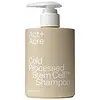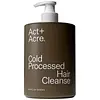What's inside
What's inside
 Key Ingredients
Key Ingredients

 Benefits
Benefits

 Concerns
Concerns

 Ingredients Side-by-side
Ingredients Side-by-side

Water
Skin ConditioningCocamidopropyl Betaine
CleansingSodium Methyl Cocoyl Taurate
CleansingGlycerin
HumectantBetaine
HumectantLactic Acid
BufferingPanthenol
Skin ConditioningSodium Benzoate
MaskingCaffeine
Skin ConditioningNiacinamide
SmoothingSodium Chloride
MaskingCoco-Glucoside
CleansingGlyceryl Oleate
EmollientSodium Gluconate
Skin ConditioningCocodimonium Hydroxypropyl Hydrolyzed Wheat Protein
CleansingHydrolyzed Rice Protein
Skin ConditioningHyaluronic Acid
HumectantIsomalt
HumectantBenzyl Alcohol
PerfumingPotassium Sorbate
PreservativeMalus Domestica Fruit Cell Culture Extract
Skin ConditioningTriethyl Citrate
MaskingJuniperus Virginiana Oil
MaskingAmyris Balsamifera Bark Oil
MaskingPogostemon Cablin Leaf Extract
PerfumingGamma-Nonalactone
MaskingIonone
AstringentElettaria Cardamomum Seed Oil
MaskingCistus Ladaniferus Resin Extract
Cananga Odorata Flower Oil
MaskingCaprylic/Capric Triglyceride
MaskingVanillin
MaskingViola Odorata Leaf Extract
MaskingHexenyl Acetate
MaskingAquilaria Agallocha Wood Oil
MaskingDimethylheptenal
PerfumingWater, Cocamidopropyl Betaine, Sodium Methyl Cocoyl Taurate, Glycerin, Betaine, Lactic Acid, Panthenol, Sodium Benzoate, Caffeine, Niacinamide, Sodium Chloride, Coco-Glucoside, Glyceryl Oleate, Sodium Gluconate, Cocodimonium Hydroxypropyl Hydrolyzed Wheat Protein, Hydrolyzed Rice Protein, Hyaluronic Acid, Isomalt, Benzyl Alcohol, Potassium Sorbate, Malus Domestica Fruit Cell Culture Extract, Triethyl Citrate, Juniperus Virginiana Oil, Amyris Balsamifera Bark Oil, Pogostemon Cablin Leaf Extract, Gamma-Nonalactone, Ionone, Elettaria Cardamomum Seed Oil, Cistus Ladaniferus Resin Extract, Cananga Odorata Flower Oil, Caprylic/Capric Triglyceride, Vanillin, Viola Odorata Leaf Extract, Hexenyl Acetate, Aquilaria Agallocha Wood Oil, Dimethylheptenal
Water
Skin ConditioningSodium Lauroyl Methyl Isethionate
CleansingSodium Cocoyl Apple Amino Acids
Skin ConditioningTriethyl Citrate
MaskingSorbitan Oleate Decylglucoside Crosspolymer
CleansingHydroxypropyl Starch Phosphate
Lauramidopropyl Betaine
CleansingGlycerin
HumectantAcrylates Copolymer
Acrylates/Beheneth-25 Methacrylate Copolymer
Adansonia Digitata Seed Oil
EmollientAmaranthus Caudatus Seed Oil
EmollientAmyris Balsamifera Bark Oil
MaskingAquilaria Agallocha Wood Oil
MaskingCananga Odorata Flower Oil
MaskingCaprylyl Glycol
EmollientCistus Ladaniferus Leaf/Stem Extract
MaskingCitric Acid
BufferingCocamide Mipa
EmulsifyingDimethylheptenal
PerfumingElettaria Cardamomum Seed Oil
MaskingGamma-Nonalactone
MaskingGlycol Distearate
EmollientHelianthus Annuus Seed Oil
EmollientHexenyl Acetate
MaskingHexylene Glycol
EmulsifyingIonone
AstringentJuniperus Virginiana Oil
MaskingLavandula Angustifolia Oil
MaskingMenthyl Ethylamido Oxalate
Skin ConditioningMoringa Oleifera Seed Oil
EmollientPanthenol
Skin ConditioningPhenoxyethanol
PreservativePogostemon Cablin Leaf Oil
MaskingPotassium Sorbate
PreservativeRosmarinus Officinalis Leaf Extract
AntimicrobialSodium Hydroxide
BufferingSodium Lauroamphoacetate
CleansingSteareth-4
EmulsifyingTetrasodium Glutamate Diacetate
Vanillin
MaskingViola Odorata Flower/Leaf Extract
MaskingXanthan Gum
EmulsifyingWater, Sodium Lauroyl Methyl Isethionate, Sodium Cocoyl Apple Amino Acids, Triethyl Citrate, Sorbitan Oleate Decylglucoside Crosspolymer, Hydroxypropyl Starch Phosphate, Lauramidopropyl Betaine, Glycerin, Acrylates Copolymer, Acrylates/Beheneth-25 Methacrylate Copolymer, Adansonia Digitata Seed Oil, Amaranthus Caudatus Seed Oil, Amyris Balsamifera Bark Oil, Aquilaria Agallocha Wood Oil, Cananga Odorata Flower Oil, Caprylyl Glycol, Cistus Ladaniferus Leaf/Stem Extract, Citric Acid, Cocamide Mipa, Dimethylheptenal, Elettaria Cardamomum Seed Oil, Gamma-Nonalactone, Glycol Distearate, Helianthus Annuus Seed Oil, Hexenyl Acetate, Hexylene Glycol, Ionone, Juniperus Virginiana Oil, Lavandula Angustifolia Oil, Menthyl Ethylamido Oxalate, Moringa Oleifera Seed Oil, Panthenol, Phenoxyethanol, Pogostemon Cablin Leaf Oil, Potassium Sorbate, Rosmarinus Officinalis Leaf Extract, Sodium Hydroxide, Sodium Lauroamphoacetate, Steareth-4, Tetrasodium Glutamate Diacetate, Vanillin, Viola Odorata Flower/Leaf Extract, Xanthan Gum
Alternatives
Ingredients Explained
These ingredients are found in both products.
Ingredients higher up in an ingredient list are typically present in a larger amount.
This ingredient is used as a perfuming ingredient, or to add a fragrance. It is described to have a woody, balsamic, slightly sweet scent.
Agarwood essential oil or oud essential oil is used to add a scent to products. It is described to have a smoky, incense, sweet tobacco smell.
Cananga Odorata Flower Oil comes from the ylang-ylang flower, Cananga odorata.
Ylang-ylang oil has slight antibacterial, antioxidant and antifungal properties. However, it also contains a number of sensitizing ingredients such as geraniol, limonene, linalool and benzyl benzoate. These compounds are known EU allergens.
The composition of this ingredient depends on the source. Luxury perfumes tend to use higher grade ylang-ylang for their fragrance. Lower grade ylang-ylang is less fragrant.
Learn more about Cananga Odorata Flower OilDimethylheptenal is a fragrance.
Cardamom essential oil is used to add a warm, spicy, and sweet scent to products.
Gamma-Nonalactone is a fragrance.
Glycerin is already naturally found in your skin. It helps moisturize and protect your skin.
A study from 2016 found glycerin to be more effective as a humectant than AHAs and hyaluronic acid.
As a humectant, it helps the skin stay hydrated by pulling moisture to your skin. The low molecular weight of glycerin allows it to pull moisture into the deeper layers of your skin.
Hydrated skin improves your skin barrier; Your skin barrier helps protect against irritants and bacteria.
Glycerin has also been found to have antimicrobial and antiviral properties. Due to these properties, glycerin is often used in wound and burn treatments.
In cosmetics, glycerin is usually derived from plants such as soybean or palm. However, it can also be sourced from animals, such as tallow or animal fat.
This ingredient is organic, colorless, odorless, and non-toxic.
Glycerin is the name for this ingredient in American English. British English uses Glycerol/Glycerine.
Learn more about GlycerinHexenyl Acetate is a fragrance.
Ionone is a fragrance.
Juniperus Virginiana Oil is the volatile oil obtained from the fruits and leaves of the Red Cedar tree. This tree is native to North America.
Panthenol is a common ingredient that helps hydrate and soothe the skin. It is found naturally in our skin and hair.
There are two forms of panthenol: D and L.
D-panthenol is also known as dexpanthenol. Most cosmetics use dexpanthenol or a mixture of D and L-panthenol.
Panthenol is famous due to its ability to go deeper into the skin's layers. Using this ingredient has numerous pros (and no cons):
Like hyaluronic acid, panthenol is a humectant. Humectants are able to bind and hold large amounts of water to keep skin hydrated.
This ingredient works well for wound healing. It works by increasing tissue in the wound and helps close open wounds.
Once oxidized, panthenol converts to pantothenic acid. Panthothenic acid is found in all living cells.
This ingredient is also referred to as pro-vitamin B5.
Learn more about PanthenolPotassium Sorbate is a preservative used to prevent yeast and mold in products. It is commonly found in both cosmetic and food products.
This ingredient comes from potassium salt derived from sorbic acid. Sorbic acid is a natural antibiotic and effective against fungus.
Both potassium sorbate and sorbic acid can be found in baked goods, cheeses, dried meats, dried fruit, ice cream, pickles, wine, yogurt, and more.
You'll often find this ingredient used with other preservatives.
Learn more about Potassium SorbateTriethyl Citrate comes from citric acid. It has masking, perfuming, and solvent properties. As a solvent, this ingredient helps disperse ingredients evenly in skincare.
One manufacturer claims this ingredient can:
According to perfume manufacturers, this ingredient is almost odorless but has a mild fruity, wine and plum scent. It can be used to mask the scent of other ingredients.
This ingredient can be plant-sourced or synthetic; it can naturally be found in cabbage and white wine.
Learn more about Triethyl CitrateVanillin is the main compound of the vanilla bean. It is naturally occuring but can also be artificially created.
This ingredient exhibits antioxidant properties but is also a known skin-irritant.
Vanillism is the term of contact-dermatitis associated with the vanilla plant. The sap of the vanilla plant triggers skin irritation, swelling, and redness.
Learn more about VanillinWater. It's the most common cosmetic ingredient of all. You'll usually see it at the top of ingredient lists, meaning that it makes up the largest part of the product.
So why is it so popular? Water most often acts as a solvent - this means that it helps dissolve other ingredients into the formulation.
You'll also recognize water as that liquid we all need to stay alive. If you see this, drink a glass of water. Stay hydrated!
Learn more about Water